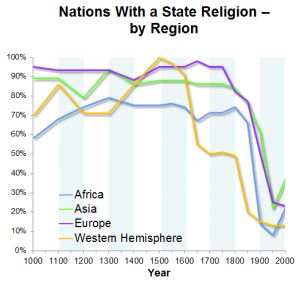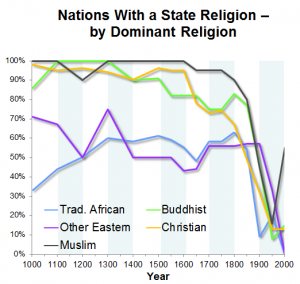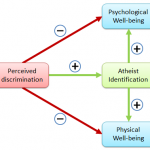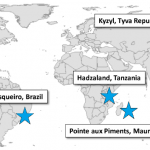 One of the characteristics of the modern world is the emergence of the secular state. In many nations there was an almost symbiotic relationship between the state and religion., but over the centuries we’ve seen a gradual disentanglement of religious authority from state authority and the emergence of the secular state.
One of the characteristics of the modern world is the emergence of the secular state. In many nations there was an almost symbiotic relationship between the state and religion., but over the centuries we’ve seen a gradual disentanglement of religious authority from state authority and the emergence of the secular state.
A fascinating new 1000-year data series from Metin Coşgel and colleagues at the University of Connecticut in the USA not only shows how this happened, but helps to explain why. And it also has a surprising and disturbing twist in the tale (you can find their Working paper here.
The first step they took was to trace back the history of modern nations – at 50-100 year intervals, they recorded which country had dominated the the territory corresponding to the modern nation at that time.
Next – and this was rather more difficult – the team researched and recorded information on politics, religions, and the relationship between political and religious authorities at these same time points.
What they found, as shown in the top graphic, is that 1000 years ago all round the world most countries had established a state religion. The first region to see secularism, surprisingly, was the Americas – as a result of the European invasions.
Beginning around 1800 Europe, Asia and Africa all began to disestablish their national religions until, by the mid 20th century, secular nations were the rule, rather than the exception. Overall, while 83% of nations had a state religion in 1000, that dropped to 16% by 1950, before rising slightly to 23% by 2000.
 Looking at the second graphic, showing how this varies according to the dominant religion at the time, gives a different picture. State religion seems to be mostly a feature of the big three – Christian, Muslim and Buddhist. And the Christians were the first to secularize.
Looking at the second graphic, showing how this varies according to the dominant religion at the time, gives a different picture. State religion seems to be mostly a feature of the big three – Christian, Muslim and Buddhist. And the Christians were the first to secularize.
The team then examined the factors that might explain why, even in the 20th century, some countries still have a state religion. What they found was that secularization in the twentieth century “is a continuation of a longer-term trend that began 300-400 years ago, though with a slight uptick in recent times.”
What was particularly notable was that the countries that are secular today are those that adopted key technologies by around 1500 – printing, paper and books.
They argue that this is evidence that the causes of modern secularism are deep rooted. In fact, they argue that rulers of nations where religion was a significant source of legitimacy actively sought to suppress these technologies to maintain their power – and those that were successful left a legacy that lasts up to modern times.
But what about that ‘slight uptick in recent times’? The team don’t speculate on the cause of that, but here’s what I think.
The uptick is only small on a global scale because it is regionalised. The resurgence of state religions occurs only in Africa and Asia, and only in Muslim countries.
Secularisation also occurred later in Muslim countries than in Christian and Buddhist countries. That means that secularism can be portrayed as a foreign concept, imposed by imperial powers – and blamed for all the problems that plague those countries today.
What this shows is that secularism is not inevitable. nations can and do roll-back secularism when those in power feel that it is to their benefit.














